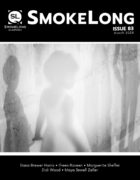In Victorian floriography, black-eyed Susans carry meanings of hope and encouragement. Flowers feel like important elements in your story: the blooms, title, ending line, and human descriptions echoing flowers—thorns, black curls, dry legs. What is the significance of flowers in your writing?
I always tie in natural elements when writing. If I don’t mention the element itself, I draw on the color, texture, sound, or shape of it. Forests are my favorite landscape as places where brutality and beauty coexist through the seasons. Black-eyed Susans are both beautiful and predatory, tough enough to drive out other wildflowers, growing easily in ravaged landscapes, or push through after a fire’s violence. Marion in the meadow of black-eyed Susans is a testament to her resilience or proximity to danger. It’s for the reader to decide which.
Marion is silent throughout. McMahon says, “She’s slower than a walk to get your own switch.” There’s a dismissal of her, almost as if she’s more of a concept than a real person. The closing line needed to be hers. She’s absorbed more in her short life than the adults give her credit for. Perhaps the information she shares about black-eyed Susans was something she learned from a caring adult, or something observed as a child. It’s her way of saying, I’m here, I have things to tell you. I’m just as significant a part of the landscape as you.
“Under the Rose” is the English translation of the Latin Sub rosa. Roses as secrecy symbolism dates to Greek and Roman mythology. Marion was created in secrecy, born in it, raised in it. I saw her life unfolding under a rose’s petals, but we don’t know if her mother will pull her fully into the light.
Your color mentions also stand out against the stark setting. This feels reminiscent of Gilman’s “The Yellow Wallpaper”—floral references, the lace-fringed ankle socks, yellow and green gumdrops, the name Marion. How and why did you choose the color and dating details?
I like telling stories in a time when the only connecting devices were mail or telephones, letting senses shine through relative quiet. The adults are sketches of themselves, interacting, but in a transactional way. Whatever passion was between them has long passed. However, Marion is fully dimensional and claims more space even as a child. There’s a picture of her in a bright yellow flower field. She’s brought bright, sweet gumdrops that she readily shares. She brings color. Marion decided to wear her fancy socks. Perhaps someone told her she’s meeting her mother and she wants to look her best, bringing the gumdrops as an offering. Marion and her mother both having sweet gumdrop fingertips is the first connection re-established since she was born and it’s a quiet moment, the opposite of her birth.
The pop culture and object references here do a wonderful job at defining the story’s backdrop—Little Debbie cakes, a hot dog, Pennsylvania, McMahon leaving on a motorcycle. The details paint the setting and how we read it. Without saying, “These are struggling blue collar people,” you share that so skillfully with your word choices. How did you choose those details? What made them important as you wrote?
I asked myself if there was one design detail to define the birth mother’s house and decided on linoleum. It would be on the floors, countertops, the wobbly kitchen table, and the mismatched chairs. This is a house with hot dogs and Little Debbies on the counter. The details filled in from there. McMahon would never own a car. He’ll transport one other person, but no more, not his entire family. It’s a statement of separation for him. He moves amongst his family, through fields and back roads, through the narrator’s house, without being attached to any of it.
Readers are immediately thrust into the story with little context. The McMahon character acts with some care—taking the baby to someone he knows, checks on Marion, sends photographs and money, and summons the narrator. Your details about the named characters are in contrast to the unnamed narrator and caretaker. The special care around Marion being misspelled feels pivotal. Even though the story begins abruptly with McMahon as only a name, one word later does heavy lifting as the narrator asks about our girl. What is the significance of your character names?
I don’t name certain characters because it can feel restrictive. I start writing with no names. It’s like this person should be experienced, not traditionally identified. Other characters’ names are so central to how they live, they tell me what to call them. The unnamed have a ghost-like quality. McMahon does caring things, but his motivations aren’t pure. The narrator seems to care less about Marion. She sees her life as a briar patch, and Marion is a “thorn.” So, the reader must experience the precise moment that shifts, when she moves from seeing Marion as “our girl” in a purely biological sense, to feeling Marion is her daughter, and she owes her something.
The sock pinwheel detail is so touching and visual. It’s lovely in a small space that you also repeated the poetic “had created an opening”—from both mother and child, as if they’re moving through a Secret Garden gate. This ties to the first line too with the violent entrance. Why that phrase and image of the mother and girl creating openings?
Both are trying to survive their environments’ hostility. If the narrator clips away enough thorns, there’s an opening, a meadow beyond the briar patch. If Marion can get to the opening and be born, she’ll survive by disguising the briar with lace until someone leads her to the opening beyond it. Marion’s longing echoes her mother’s.
What are you working on next?
I have two flash pieces out there looking for homes. One has ghosts and flowers! The other is a very simple story about loneliness. I’m also stitching some of my flash pieces together into a little village of stories.



 The core workshop of SmokeLong Fitness is all in writing, so you can take part from anywhere at anytime. We are excited about creating a supportive, consistent and structured environment for flash writers to work on their craft in a community. We are thrilled and proud to say that our workshop participants have won, placed, or been listed in every major flash competition. Community works.
The core workshop of SmokeLong Fitness is all in writing, so you can take part from anywhere at anytime. We are excited about creating a supportive, consistent and structured environment for flash writers to work on their craft in a community. We are thrilled and proud to say that our workshop participants have won, placed, or been listed in every major flash competition. Community works.